Buildings constructed during the 1930s and 1940s were often designed in the Streamline Moderne style, characterized by rounded corners, semicircular bays, terra cotta accents, glass blocks and metal, and smooth exterior finishes. The style was inspired by automation and aerodynamics. A rapid sense of movement was imparted by narrow horizontal bands of windows that frequently wrapped around the corners and by horizontal layering on the building’s façade that used changes in colors or materials. One of the best examples of this style found within Petaluma’s downtown is the former Leader Department Store and future headquarters to Amy’s Kitchen[1].
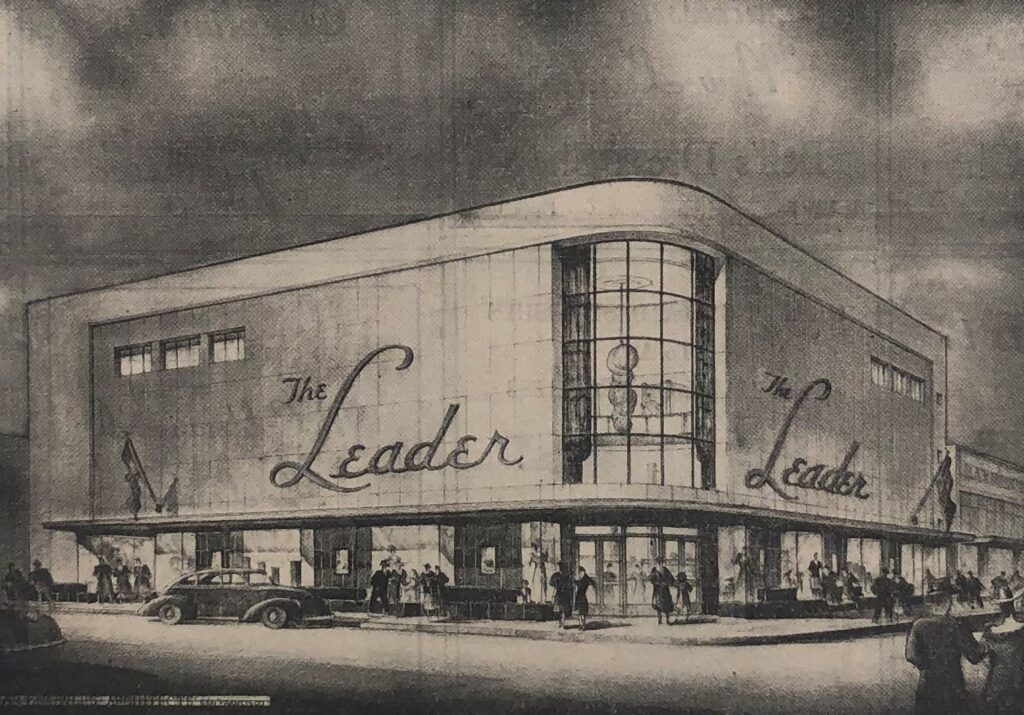
In 1940 Mose Goldman, a prosperous local merchant and civic leader, hired San Francisco architects Wayne Hertzka and William Knowles to draw plans for what was considered the largest and most modern department store in the North Bay devoted entirely to ladies’ wear. In later years this firm gained recognition for its collaboration with Skidmore, Owings, and Merrill on the Crown Zellerbach building, a San Francisco landmark.
Goldman likely selected Hertzka & Knowles because of their association with Santa Rosa’s Rosenberg Department Store (1937) and the J. J. Newberry Company variety store[2] (1940). Max and Fred S. Rosenberg commissioned plans for both buildings. A model of the Rosenberg Department store was exhibited at the 1939 World’s Fair on Treasure Island.
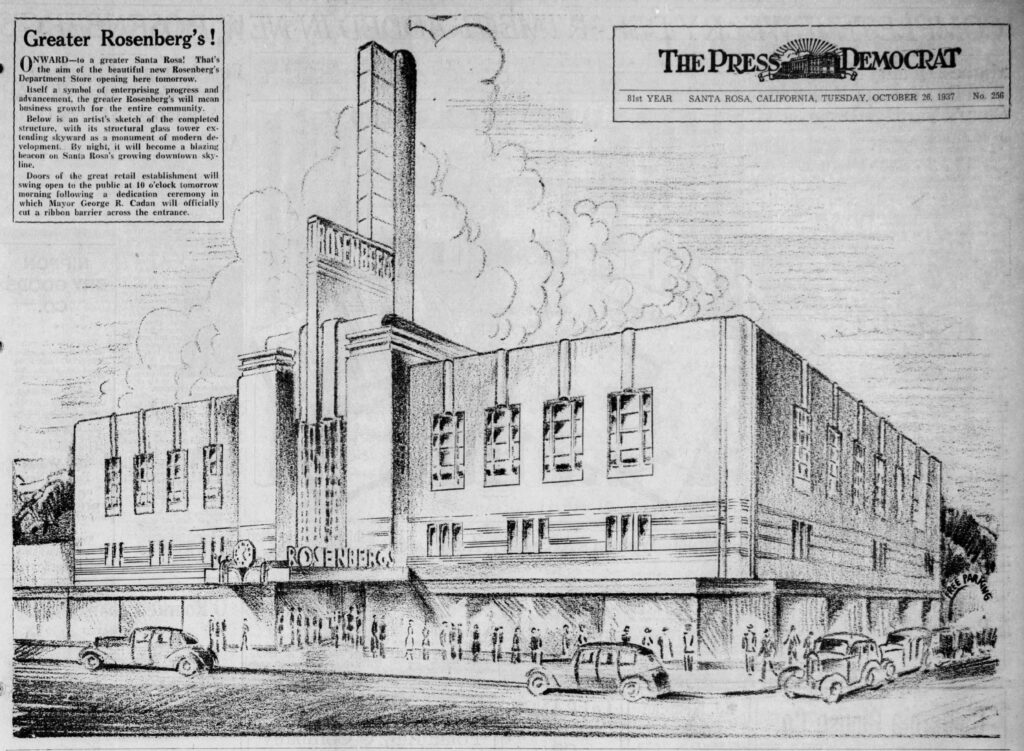
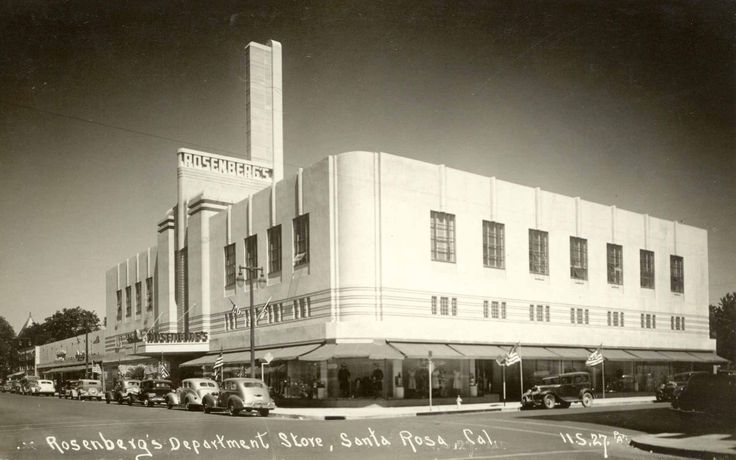
Goldman came to Petaluma from Cloverdale where he had operated a general store since 1913. In 1920 he purchased Newburgh & Company, one of Petaluma’s oldest ladies’ furnishing stores having been established by Edward Newburgh in 1861. In 1924 Goldman acquired Cockburn & Berger, successor to Raymond Bros. at 113-119 Main Street.
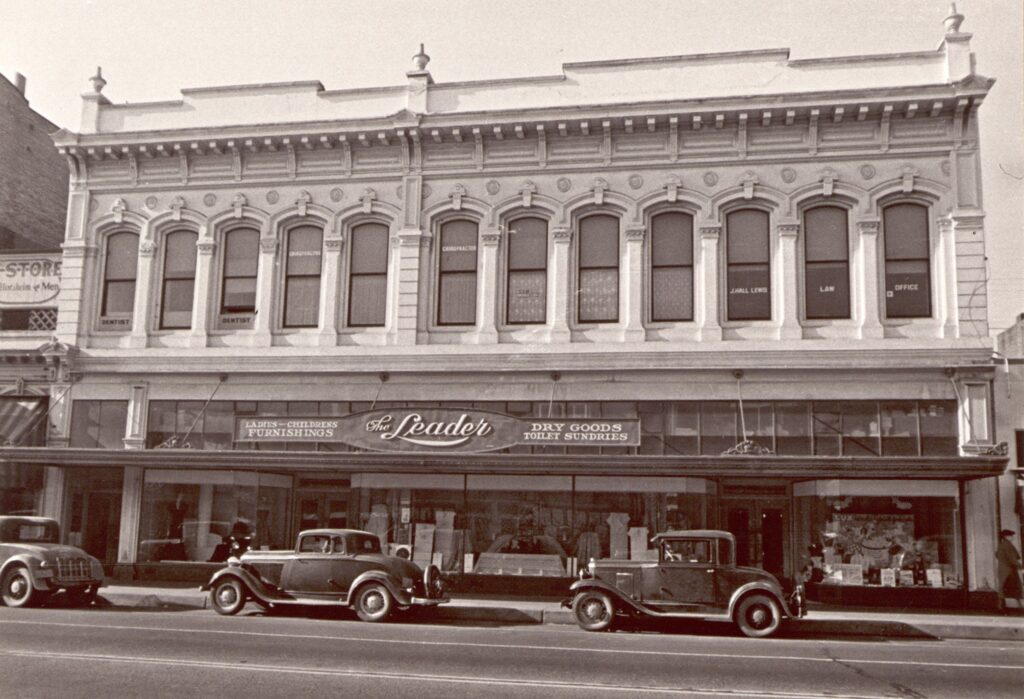
Groundbreaking for the new Leader Department Store, at the corner of Kentucky Street and Western Avenue, occurred in January 1941. William Rapp, a Santa Rosa builder, who would later serve on the Santa Rosa City Council, was awarded the construction contract after submitting a bid for $52,160.25 to complete the three-story, 1,900 square-foot structure which included a rooftop penthouse. G.M. Simonson was the consulting engineer. Modern in design and appointments, the new building afforded approximately two- and one-half times the floor space of the Main Street store, which Goldman leased from Josephine Gwinn.
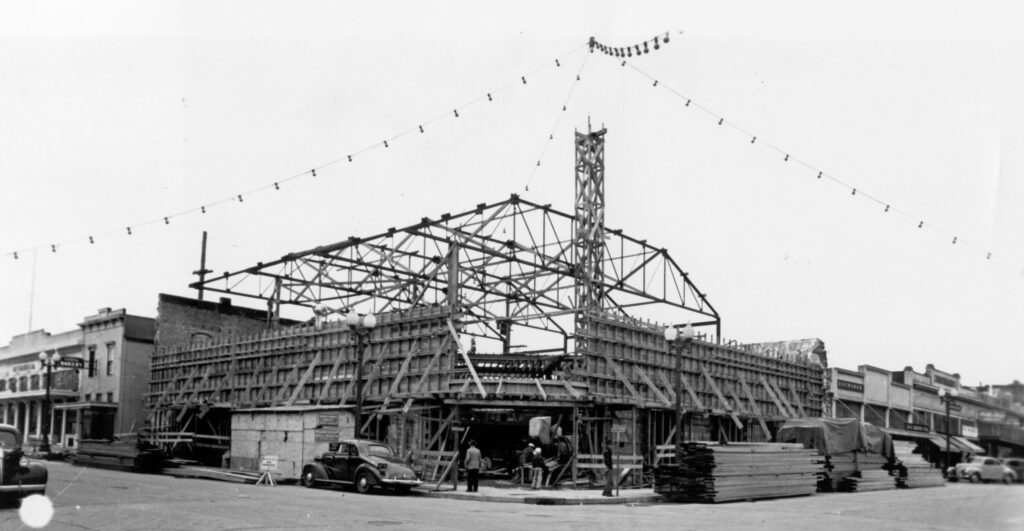
Construction of The Leader required razing the Case Block. The Case Block was named after its owner Austin B. Case, a native of New York who came to Petaluma in 1859. Numerous businesses occupied the building over the years including Ott and Veale Grocery, Neil and Gray Grocery, and C. Gervasoni & Sons Delicatessen.
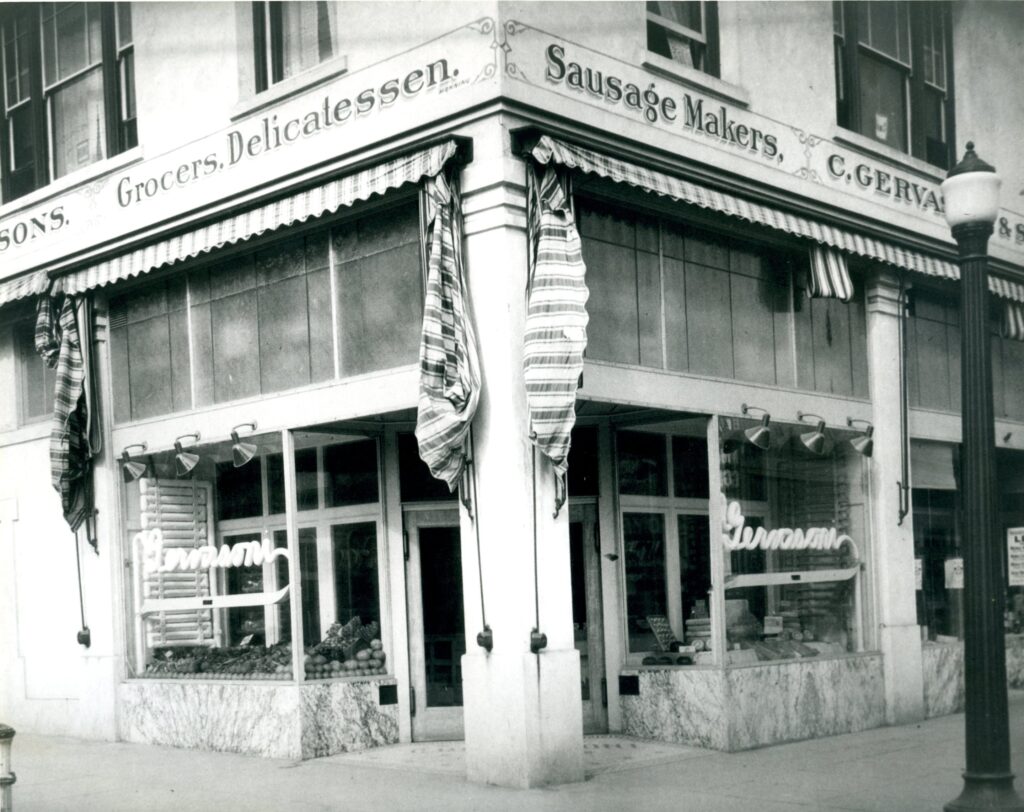
Following the death of Case in 1902, his wife Harriet and later his daughter Carrie Hooper maintained rooms for rent on the second floor.
The Case Block was home to Purity Grocery Store in 1939 when Goldman purchased the building from the Hooper estate. Purity moved to the former site of the Methodist church at the corner of Keller Street and Western Avenue[3].
On August 7, 1941, the day before the grand opening of The Leader, the Petaluma Argus-Courier included an unprecedented eight page “Leader Congratulatory Section” as a supplement to its daily edition. The Leader was described in this spread as a modern department store “built for the convenience of the women of Petaluma and the North Bay Counties.”
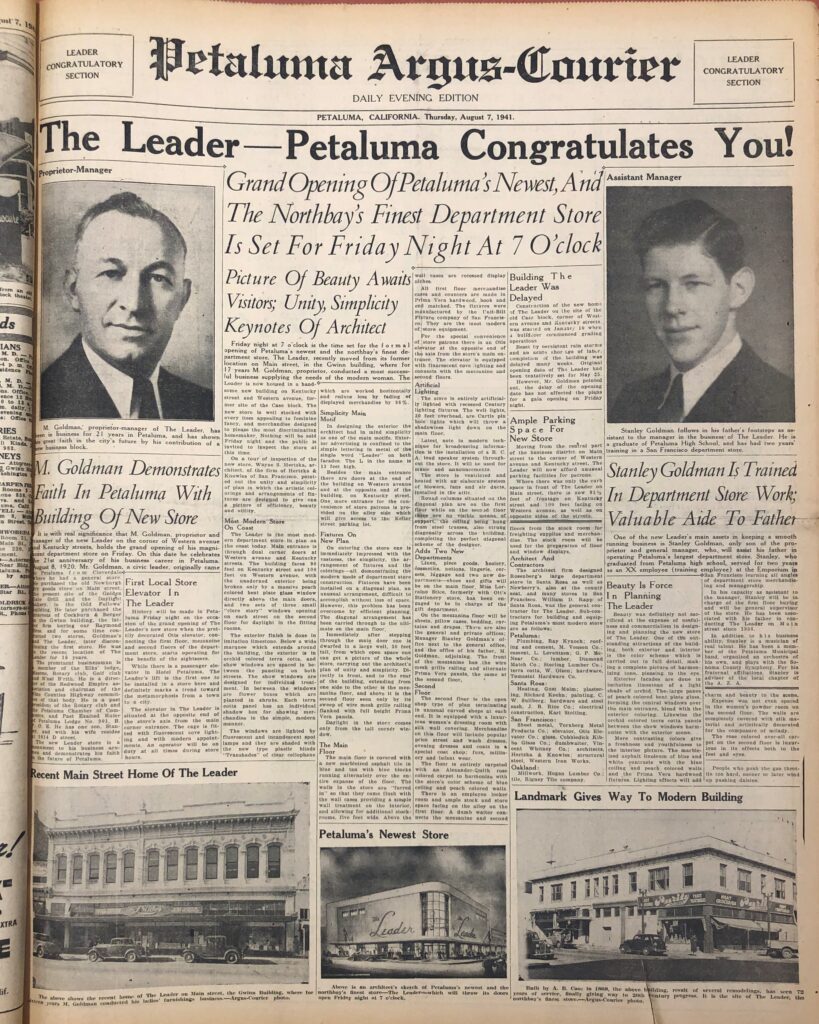
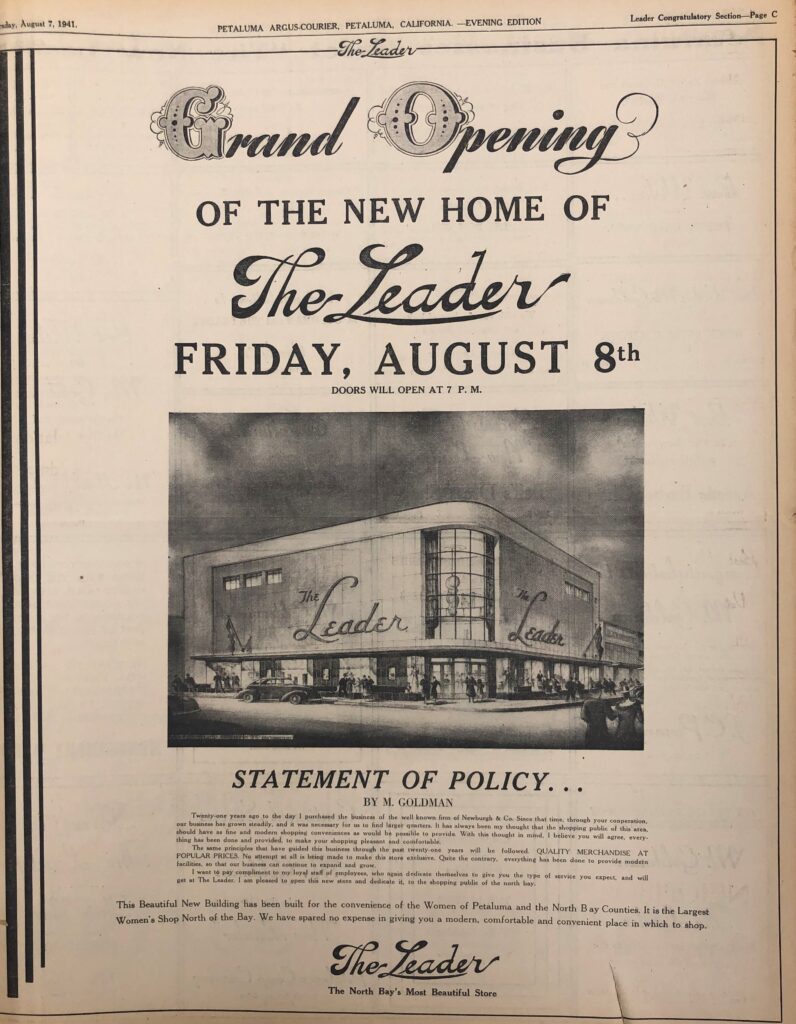
The new building included an Otis elevator, reported to be the first of its kind in Petaluma, but in fact, Montgomery Ward likely claimed that distinction having installed a passenger elevator in their Main Street building in 1929[4]. Other aspects of the building’s modernity included 100% artificial lighting, and windows shades called “Transhades” that were amber in color and made of celluloid and rubber. The shades worked horizontally and were said to prevent fading of merchandise by 98%. The building was equipped with an RCA loudspeaker system, and the main floor was covered with a new marbleized asphalt tile.
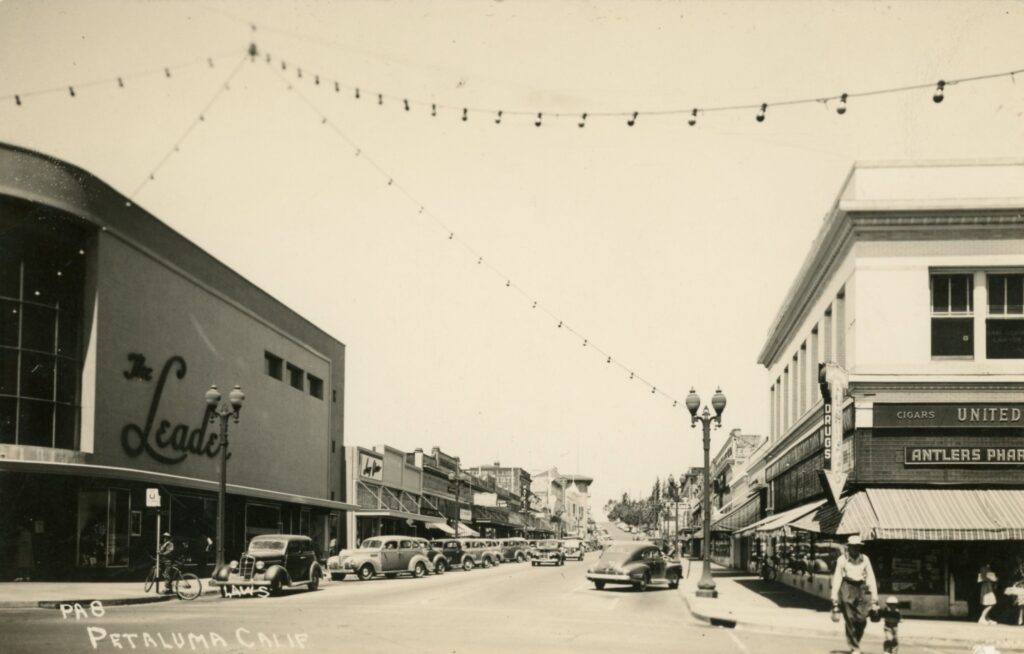
The architects “had simplicity in mind” when they chose a faux limestone finish for the building’s exterior. The color was described as “a light shade of orchid.” Large panes of peach-tinted bent plate glass formed the central windows of the main entrance that blended with the exterior coloring.
Advertising was confined to simple metal letters spelling “Leader” on both building facades. The L was 13 feet tall.
The new Leader was not the only department store in town. J.C. Penney opened a store in the Wickersham Building in 1922[5] and as stated above Montgomery Ward had a store at Main and Western. But unlike these two businesses, The Leader was independently owned, specialized in women’s wear and offered its customers a modern shopping experience.
In 1946 W.R. Carithers and Sons, Inc., owners of the White House in Santa Rosa and stores in Napa and Vallejo, purchased The Leader from Goldman. Mervyn Lash, an existing Carithers employee, replaced Stanley Goldman, son of Mose Goldman, as general manager. Stanley went on to establish a partnership with F. Roy Chelton, who had worked for Sherman and Clay and founded the Stanroy Company in Santa Rosa[6].
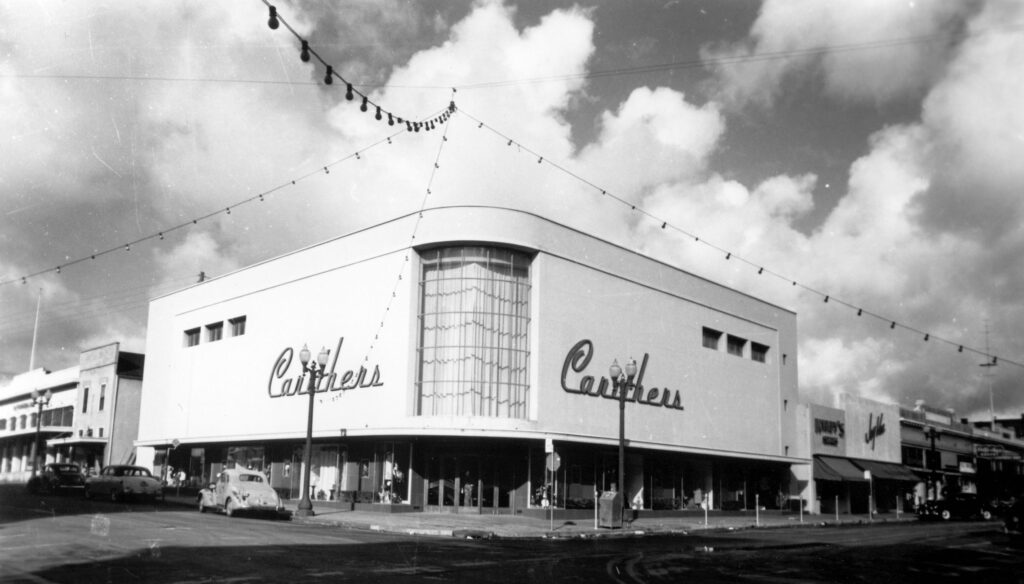
In June 1947, while living in San Francisco Mose Goldman was charged and pled guilty to income tax evasion. The U.S. District Attorney’s office found that Goldman had not filed any tax returns between 1927 and 1947. This lack of payment was discovered during divorce proceedings. Mose Goldman and Lena Fleisher Goldman were officially divorced after 37 years of marriage in Reno. Nevada on July 27, 1948. Two days later Mose married Betty E. Sword of New York. The couple lived in San Francisco for a time and later Los Gatos. They eventually settled in San Jose where Mose managed a Golden Rule store. He died on April 28, 1970.
Carithers catered to the needs of the whole family and household and served their customers and the community well before closing in 1985. A year later, the building was sold to brothers Michael and Mark Thomas, who owned Couches, Etc., a Petaluma business since 1979.
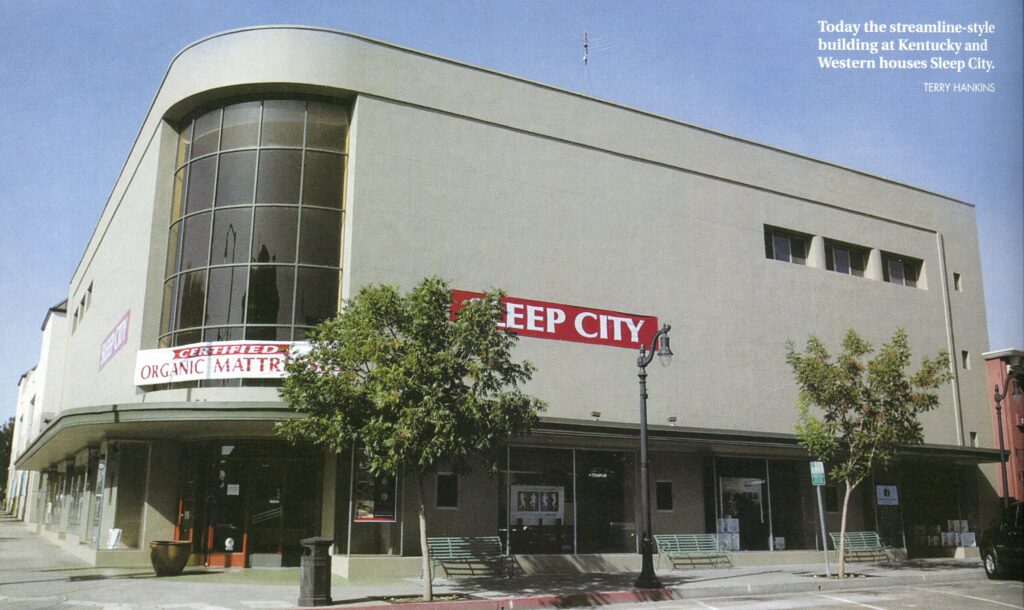
In 2007, Couches, Etc. closed and the property sat vacant until 2009 when Sleep City moved in. A plan to convert a portion of the building to office space was proposed in 2012, but that never came to fruition. In 2016, the building was leased to Ramos Furniture.
According to Sonoma County Assessor’s records, the building sold in March 2018 for $2,720,000 and again in December 2021 for $5,300,000. In July 2022, plans to modify the structure to accommodate a new use as the headquarters for Amy’s Kitchen were approved by Petaluma’s Historic and Cultural Preservation Committee. As a contributor to Petaluma’s nationally registered historic commercial district (since 1995), a review by the committee was required as part of the permitting process.
Although the use will change, the overall historic character of one of Petaluma’s most significant Streamline Moderne buildings will be retained and the exterior will continue to read as the modern department store it was intended to be.
This is an expanded version of an article that appeared in the Petaluma Magazine, a Petaluma Argus Courier publication, in 2009.
As special shout out to staff at the Sonoma County History & Genealogy Library who pulled a hard copy of the August 7, 1941 special edition of the Petaluma Argus Courier from off site. Having access to an original newspaper made such a difference in the quality of images shared here.
[1] For details on the Amy’s Kitchen Downtown Corporate Office project go to https://cityofpetaluma.org/amys-kitchen/
[2] J. J. Newberry Company store was located at 707 Fourth Street, Santa Rosa. The contractor was William D. Rapp who also built the Leader. Santa Rosa’s J. J. Newberry store had 27 departments offering every variety of merchandise from five cents to $1 and had a soda fountain. The store was the 491st in a nationwide chain founded in Pennsylvania in 1911.
[3] Current site of Petaluma Market
[4] The Hotel Petaluma, completed in 1924, had a passenger elevator, but the Montgomery Ward lift was the first to be installed in a store.
[5] Once the Leader moved out 113-119 Main Street, J.C. Penney moved in.
[6] Stanroy Music Center opened in February 1947 at 622 Fourth Street, Santa Rosa. According to a September 7, 1946 Petaluma Argus Courier article, the building on Fourth Street was designed by Wayne Hertzka.
Sources:
Longstreth, Richard. The American Department Store Transformed, 1920-1960. New Haven and London: Yale University Press, 2010.
Page & Turnbull. Amy’s Kitchen, 109 Kentucky Street Proposed Project Impact Analysis. Prepared for Amy’s Kitchen and submitted to the City of Petaluma, May 6, 2002.
Petaluma Argus Courier
“New Building for Petaluma is Rumored” Sept. 7, 1939, pg. 8
“Ground Is Broken for Modern New Leader Store; Contract Awarded to Wm. D. Rapp” Jan. 16, 1941, pg. 5
“Leader Celebrates 21st Birthday Anniversary” May 9, 1941, page 90 (Petaluma Argus-Courier 85th Anniversary Progress Edition)
“The Leader – Petaluma Congratulates You!” Aug. 7, 1941 pgs. 13-20
“The Leader Has Grand Opening” Aug. 9, 1941, pg. 2
“Goldman Sells Leader to Santa Firm” June 1, 1946, pg. 1
“M. Goldman Accused of Failure to File Income Tax Returns” May 21, 1947, pg. 1
“Goldman will Plead Guilty Says Counsel” June 12, 1947, pg. 1
“Goldman Guilty, Gets Probation Hearing” June 17, 1947, pg. 1
“M. Goldman to Serve 6 Months in County Jail” June 30, 1947, pg. 1
“Mrs. Goldman Wins Divorce in Reno” July 28, 1948, pg. 1
“M. Goldman, N.Y. Divorcee Are Wed in Reno” July 31, 1948, pg. 1
“Carithers store to close next month” July 30, 1985, pg. 1
“Plans for Amy’s Future HQ in Downtown Petaluma Take Step Forward” July 13, 2022, pg. 1
Rinehart, Katherine J. “Streamline style building one of downtown’s sleekest.” Petaluma Magazine, Winter 2009, 58-59.
Santa Rosa Republican
“M. Goldman Is Given Six Month Term” July 1, 1947, pg. 9
Sonoma, Lake & Mendocino Counties October 1921 Telephone Directory, pg. 2
The Press Democrat
“Modern Newberry Department Store to be Opened Here” April 17, 1941, Special Section, pgs. 9-13
 Treasures from the Sonoma County Archives
Treasures from the Sonoma County Archives
Wonderful article. Thank you. I think I’m going to be on the lookout for a “light shade of orchid” paint option for my next house!
Thanks for the deep history on that important downtown corner.
You’re most welcome! Two additional bits of information: 1) during the July 17, 1944 munitions explosion at Port Chicago the windows on the Western Avenue side of the building blew out, and 2) the building appears in the 1986 movie When Peggy Sue Got Married.